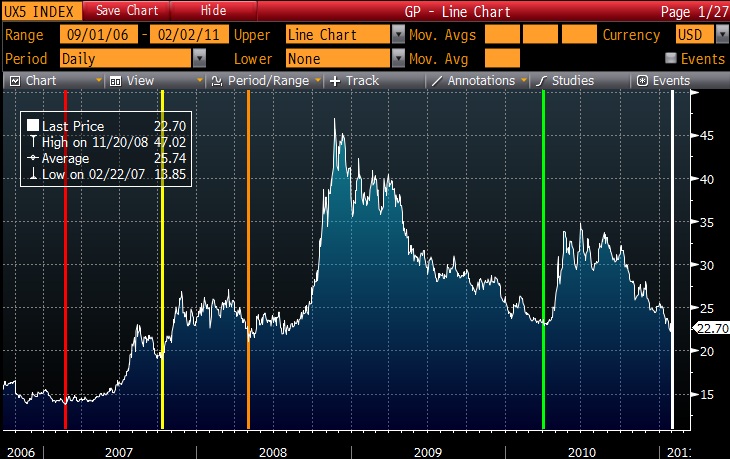By Stuart Wallace and Claudia Carpenter
(Bloomberg) -- Commodities, last month’s best- performing asset class, jumped to their highest in more than two years on prospects for strengthening demand and shortages as global growth improves and extreme weather destroys crops.
The Standard & Poor’s GSCI Total Return Index of 24 commodities rose as much as 0.6 percent to 5,152.9 points, the highest since November 2008. The gauge was at 5,151.7 as of 10:41 a.m. in London. Cotton, rubber and copper rose to records and Brent crude oil advanced for a fifth day to $102.64 a barrel, the most since September 2008.
Commodities have risen for five consecutive months, the longest winning streak since 2004, bolstered by an improving economic outlook. Raw materials also advanced as drought in Russia, flooding in Canada and a cyclone in Australia ruined crops and as protests across the Middle East spurred concern about supply disruptions.
“What is new is that the fundamentals are getting tighter and the political risk premiums are increasing for energy and agriculture,” said Jean-Marc Bonnefous, a co-founder of London- based Tellurian Capital Management LLP, which invests in energy, metals and agriculture.
Copper for delivery in three months rose as much as 0.6 percent to $10,000 a metric ton on the London Metal Exchange today, extending this year’s advance to 4 percent. Aluminum, zinc, tin, lead and nickel also gained.
Supplies of copper, nickel and tin will all fall short of demand this year, according to Barclays Capital. A decade-long boom in commodities may last “a couple of years” longer before supply catches up with demand, billionaire investor George Soros said in an interview in Davos, Switzerland on Jan. 27.
Rubber Futures
Rubber futures traded on the Tokyo Commodity Exchange gained as much as 3.8 percent to an all-time high of 490.2 yen a kilogram ($6,004 a ton) as rain in Thailand, Indonesia and Malaysia, the top three growers, curbed output.
Brent crude rose for a fifth day in London as protests in Egypt turned violent, prompting concern that supplies will be disrupted and unrest may spread to other parts of the Middle East. Egyptian President Hosni Mubarak has faced a week of unrest. Protesters were also gathering in the Yemeni capital of Sana’a today and Jordan’s King Abdullah replaced his prime minister this week.
“All eyes in the oil market are on the riots and protests in Egypt right now,” said Robert Montefusco, senior broker at Sucden Financial in London. “That’s keeping prices strong, though there hasn’t been any disruption to supplies.”
Suez Canal
Egypt’s Suez Canal is open and operating normally today, Ahmed El Manakhly, head of traffic for the Suez Canal Authority, said by phone. About 50 ships were transiting yesterday and the same number is expected today, he said.
Raw sugar was little changed in New York trading after jumping to a 30-year high of 36.08 cents a pound yesterday. Sugar cane plantations in Australia, the third-largest exporter, suffered severe damage after Tropical Cyclone Yasi cut through an area accounting for a third of output.
“We are going to see a massive reduction in the amount of sugar that region produces,” Steve Greenwood, chief executive officer of Brisbane-based producers group Canegrowers, said today on Bloomberg television.
World food prices surged to a record last month, led by increases in costs for dairy products, the United Nation’s Food and Agriculture Organization said in a report today.
Continue reading this article >>











